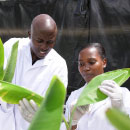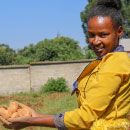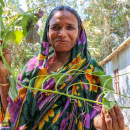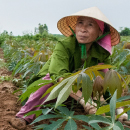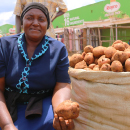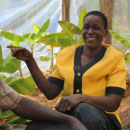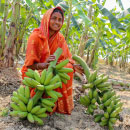As soon as one begins to examine in detail the ways in which different groups of people express their preferences for certain crop or animal traits, the complexities of production systems become more and more apparent. Cassava and banana in sub-Saharan Africa provide good examples.
Early in the NextGen Cassava project, researchers started to ask how different groups—not just women and men, but also farmers, processors, marketers and consumers—viewed specific aspects of the crop. One surprise that came to light was that while women were often said to regard food quality traits as most important, these traits were equally important to many men. This contradicted gender stereotypes that see cassava as a ‘women’s crop’. This and other information surfaced by the Survey Division established in the International Institute for Tropical Africa (IITA) indicate the need for gender-responsive approaches, rather than disaggregation of data by sex.
A gender-responsive approach also takes into account the tasks that people perform along the production chain, their social status, access to land and other resources, including finance, immigrant status and many other factors. Doing so allows researchers to develop a focused and structured questionnaire that can target many people in a community and provide nuanced information about desirable traits.

Putting a gender-responsive approach into wider practice depends on researchers being able to use the method with confidence. To meet that need, RTB, through the Gender and Breeding Initiative, developed a Decision Checklist that any breeding program can use. The checklist tackled the need for breeders to consider specifically those stages in the breeding cycle where critical decisions can directly affect the lives of women. Poor decisions at these points can aggravate household food insecurity and poverty.
The checklist itself consisted of ten key questions related to seven decisions in the breeding cycle. It set out the kind of information on gender needed for each decision, with a focus on why a particular trait is preferred. Is it for ease of processing, or yield, or household food security, or sales potential? The goal was to ensure that collecting this information would be systematically included in breeding programs. The decisions include fundamental questions such as “Who are the potential customers?”. There are also decisions about which traits breeders should prioritize, knowing that traits do not exist in isolation. They are worth prioritizing only inasmuch as they meet the needs of the potential customers.
The points covered originally in the checklist were subsequently developed into the G+ Customer Profile tool and the G+ Product Profile Query tool. Feeding into the development of those tools were pilot studies that made use of a gender-responsive approach to examine customer preferences.
In Nigeria, they looked at how varieties were processed into marketable foods. Preferences depended far more on the tasks that people had to perform along the production chain than on gender, even though many tasks are indeed gendered to a greater or lesser extent. Women who grew cassava were as concerned about yield and storage as men. Men who processed cassava were as concerned about the quality of the end product as women.
In Uganda and Tanzania, women and men banana growers had similar preferences with regard to cooking quality, but only women put higher value on traits related to productivity, such as early maturity and high suckering ability. Women and men alike prefer traditional varieties because they are better to eat. Eating quality is hard to define, but its importance forces breeders to understand how it relates to physicochemical measurements and which heritable traits are most important in determining eating quality.

